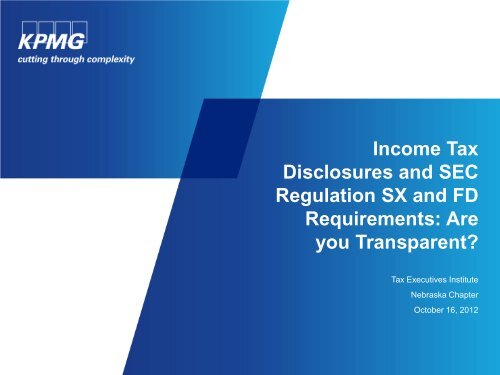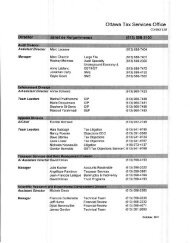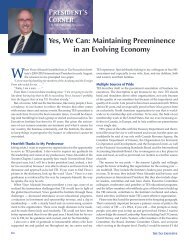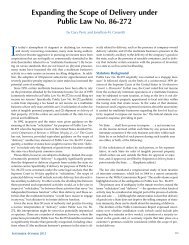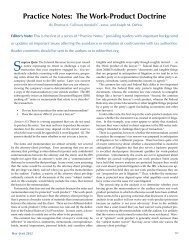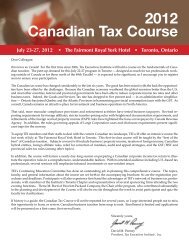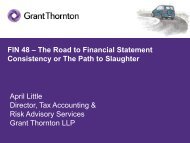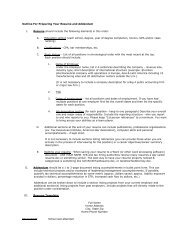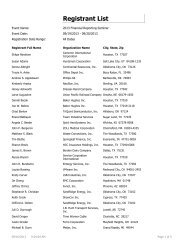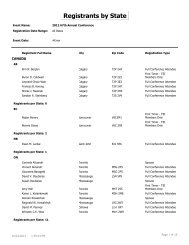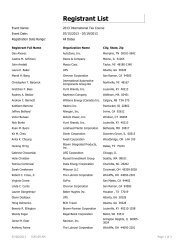KPMG Talkbook template - Tax Executives Institute, Inc.
KPMG Talkbook template - Tax Executives Institute, Inc.
KPMG Talkbook template - Tax Executives Institute, Inc.
You also want an ePaper? Increase the reach of your titles
YUMPU automatically turns print PDFs into web optimized ePapers that Google loves.
<strong>Inc</strong>ome <strong>Tax</strong>Disclosures and SECRegulation SX and FDRequirements: Areyou Transparent?<strong>Tax</strong> <strong>Executives</strong> <strong>Institute</strong>Nebraska ChapterOctober 16, 2012
With You TodayMichael Lawler, Partner, <strong>KPMG</strong>Michael is a <strong>Tax</strong> partner in <strong>KPMG</strong>’s Chicago office Federal <strong>Tax</strong> practice, Consumer and Industrial Markets group,where he focuses on the U.S. tax obligations of multinational companies. Michael’s engagement experienceincludes assisting clients with the application of income tax accounting principles including serving as the leadpartner on several multinational income tax provision review and preparation engagements.Tim Andreasen, Managing Director, <strong>KPMG</strong>Tim is a <strong>Tax</strong> Managing Director in <strong>KPMG</strong>’s Nebraska Business Unit. He has more than 18 years of experience intax planning and structuring of transactions for public and privately held clients. Tim’s experience includesassisting clients with structuring for mergers’ acquisitions and divestures, corporate tax planning and compliance,and consulting with clients regarding specific tax planning strategies. Tim has also been an instructor for <strong>KPMG</strong>’s<strong>Tax</strong> Skills Seminars relating to “FAS 109 Computations” and “Professionalism & Integrity.”Bradley Homant, Partner, <strong>KPMG</strong>Brad is an Audit Partner in the Omaha office. He has more than 15 years of experience with <strong>KPMG</strong>, whichincludes providing financial statement audit services in a variety of industries and rotations to the Department ofProfessional Practice (DPP) – Audit and Advisory Services in New York, and as a Practice Fellow at the FinancialAccounting Standards Board (FASB).© 2012 <strong>KPMG</strong> LLP, a Delaware limited liability partnership and the U.S. member firm of the <strong>KPMG</strong> network of independentmember firms affiliated with <strong>KPMG</strong> International Cooperative (“<strong>KPMG</strong> International”), a Swiss entity. All rights reserved.NDPPS 1056652
Agenda• Effective <strong>Tax</strong> Rate as an Indicator• Risk (<strong>Tax</strong> and <strong>Tax</strong>-related Business)• Valuation Allowances• Overall Disclosures© 2012 <strong>KPMG</strong> LLP, a Delaware limited liability partnership and the U.S. member firm of the <strong>KPMG</strong> network of independentmember firms affiliated with <strong>KPMG</strong> International Cooperative (“<strong>KPMG</strong> International”), a Swiss entity. All rights reserved.NDPPS 1056653
Effective <strong>Tax</strong> Rate as an IndicatorEffective tax rate disclosures:• Geographic mix of income• Usefulness as an indicator of trends© 2012 <strong>KPMG</strong> LLP, a Delaware limited liability partnership and the U.S. member firm of the <strong>KPMG</strong> network of independentmember firms affiliated with <strong>KPMG</strong> International Cooperative (“<strong>KPMG</strong> International”), a Swiss entity. All rights reserved.NDPPS 1056654
SEC Comments on <strong>Inc</strong>ome <strong>Tax</strong>es• We also note that your response indicates the reason for the higher effective rate in 2010 isdue to a higher proportion of income being derived from your businesses in Latin America,the United Kingdom, and the U.S., which have higher tax rates than Spain. However, theeffect of different tax rates disclosed in Note 27 is a net decrease from the statutory tax rateof 30 percent, which seems to indicate you are deriving income from foreign jurisdictionswith lower tax rates than Spain. Please reconcile this apparent inconsistency.• Expand your disclosure to separately disclose the effect of the income tax rates of foreignjurisdictions so that a reader may understand the significant factors that affect your incometax expense. Clearly disclose the basis of these adjustments (i.e., whether they are thestatutory tax rates or the effective tax rates) in each of the countries for which you incur amaterial amount of tax expense.• We note …that income before income taxes pertaining to Ireland was significant to totalincome (loss) before income taxes for all periods presented. Please consider disclosing ingreater detail the impact on your effective income tax rates and obligations of havingproportionately higher earnings in countries with statutory income tax rates lower than theU.S. A separate discussion of foreign effective income tax rates may be necessary tounderstand your results of operations...© 2012 <strong>KPMG</strong> LLP, a Delaware limited liability partnership and the U.S. member firm of the <strong>KPMG</strong> network of independentmember firms affiliated with <strong>KPMG</strong> International Cooperative (“<strong>KPMG</strong> International”), a Swiss entity. All rights reserved.NDPPS 1056655
Risk (<strong>Tax</strong> and <strong>Tax</strong>-related Business)Disclosures include:• Amount of unrecognized tax benefits that, if recognized, would affect the effective tax rate• Information about reasonably possible changes in unrecognized tax benefits• Amount of cash trapped in foreign subsidiaries• Other items around indefinitely reinvested earnings© 2012 <strong>KPMG</strong> LLP, a Delaware limited liability partnership and the U.S. member firm of the <strong>KPMG</strong> network of independentmember firms affiliated with <strong>KPMG</strong> International Cooperative (“<strong>KPMG</strong> International”), a Swiss entity. All rights reserved.NDPPS 1056656
SEC Comments on <strong>Inc</strong>ome <strong>Tax</strong>es• Reference is made to the disclosures regarding Notices of Proposed Adjustment from theIRS for the 20X5 and 20X6 calendar years relating to transfer pricing with your foreignsubsidiaries. Please explain to us how you consider and historically considered transferpricing when evaluating tax contingencies and the required tax contingency disclosures…• We note your disclosure that you did not record taxes on undistributed earnings of $XXXmillion at December 31, 20X0 since these earnings are considered to be permanentlyreinvested. We also note from your balance sheet that as of December 31, 20X0 there is asignificant amount of cash recorded on the balance sheet. If a significant amount of thiscash on the balance sheet relates to cash held by foreign subsidiaries, please revise theliquidity section of MD&A to disclose the amount of cash and short-term investments held byforeign subsidiaries; a statement that the company would need to accrue and pay taxes ifrepatriated; and a statement that the company does not intend to repatriate the funds.• …In view of this highly material deferred tax liability, please expand the notes to specificallydiscuss the difference between your tax and book reporting for depreciation and the periodsyou expect this deferred tax liability to reverse and require a significant increase in yourcurrent income tax expense as well as a cash outlay of current taxes payable…in yourMD&A analysis of cash flows and liquidity, please inform readers as to the reasonablelikeliness of an exposure to a material future cash requirement…© 2012 <strong>KPMG</strong> LLP, a Delaware limited liability partnership and the U.S. member firm of the <strong>KPMG</strong> network of independentmember firms affiliated with <strong>KPMG</strong> International Cooperative (“<strong>KPMG</strong> International”), a Swiss entity. All rights reserved.NDPPS 1056657
Valuation AllowancesConcerns include:• Consistency between disclosures and actions• Weighting of positive and negative evidence• Timing of changes in valuation allowances© 2012 <strong>KPMG</strong> LLP, a Delaware limited liability partnership and the U.S. member firm of the <strong>KPMG</strong> network of independentmember firms affiliated with <strong>KPMG</strong> International Cooperative (“<strong>KPMG</strong> International”), a Swiss entity. All rights reserved.NDPPS 1056658
SEC Comments on <strong>Inc</strong>ome <strong>Tax</strong>es• You have recorded an income tax benefit in 2011. Your disclosures regarding the realizationof the net deferred tax asset seems focused on your ability to carry the losses forward tofuture profitable years and the trends and anticipated strength of earnings. Given the lossesrecognized in the last two fiscal years, please provide us with a detailed analysis to supportyour conclusion to recognize a tax benefit. Your response should address both positive andnegative evidence…• Please provide us with a detailed analysis to support your conclusion that no additionalvaluation allowance is warranted. Your response should address both positive and negativeevidence…• We note the significant reduction in your valuation allowance recorded during fiscal 20X0.Please describe, supplementally and in detail, the events and circumstances that resulted inthis reduction and explain how your accounting complies with GAAP. As a related matter,please identify the location of your related disclosures in MD&A and/or elsewhere throughoutthe filing.© 2012 <strong>KPMG</strong> LLP, a Delaware limited liability partnership and the U.S. member firm of the <strong>KPMG</strong> network of independentmember firms affiliated with <strong>KPMG</strong> International Cooperative (“<strong>KPMG</strong> International”), a Swiss entity. All rights reserved.NDPPS 1056659
Overall Disclosures• Disclosure committee interaction• <strong>Tax</strong>ing authority’s interpretation• Allocation of income taxes• Tables of deferred tax assets and liabilities• Components of income before income taxes and income tax expense• Reasonably possible changes in the valuation allowance© 2012 <strong>KPMG</strong> LLP, a Delaware limited liability partnership and the U.S. member firm of the <strong>KPMG</strong> network of independentmember firms affiliated with <strong>KPMG</strong> International Cooperative (“<strong>KPMG</strong> International”), a Swiss entity. All rights reserved.NDPPS 10566510
Questions?
© 2012 <strong>KPMG</strong> LLP, a Delaware limited liability partnership andthe U.S. member firm of the <strong>KPMG</strong> network of independentmember firms affiliated with <strong>KPMG</strong> International Cooperative(“<strong>KPMG</strong> International”), a Swiss entity. All rights reserved.NDPPS 105665The <strong>KPMG</strong> name, logo and “cutting through complexity” areregistered trademarks or trademarks of <strong>KPMG</strong> International.


